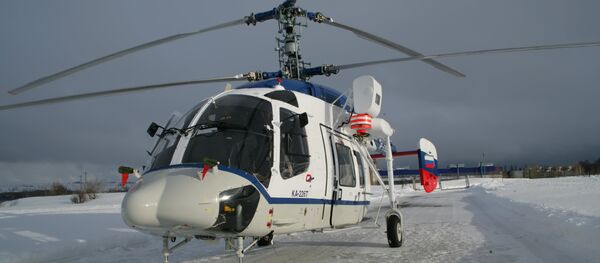The Moscow Aviation Center was established in 2003. Since then, its helicopters have put out numerous major fires, evacuated the victims of transport accidents, and even participated in the elimination of the large-scale forest fires surrounding the city in 2010.
Today, MAC's park of aviation center consists of ten multipurpose helicopters, operating from 29 helipads, six of which are based at medical facilities, one on the Moscow Ring Road and 22 in the Troitsky Administrative region southwest of the capital. The air rescue team is headquartered at the Ostafyevo International Business Airport, about 14 km south of the Moscow Ring Road.
While its formal area of responsibility is limited to Moscow and the Moscow region, MAC's experienced pilots, doctors, engineers, technicians, and dispatchers are also regularly deployed to other regions of Russia, and even to other countries.
Mil Mi-26T: Big Chopper for Big Problems
The Mi-26T, an upgrade of the Mi-26, the world's largest heavy lift cargo helicopter, is the flagship of Moscow's airborne fire rescue fleet. Flying at speeds up to 270 km/h, the chopper, which can carry up to 15 tons-worth of water with its spillway device, or 20 tons of cargo in its cabin, can also transport up to 60 injured people in ambulance mode.

In perhaps its most dramatic mission to date, the heavy chopper battled a fire on the 67th floor of the Vostok Tower at the Moscow City business center. Working with four other MAC choppers to put out a blaze that firefighters on the ground simply could not tame, the Mi-26T held its own against 15 m/s winds, at night, and helped to dump about 300 tons of water onto the raging inferno.
Kamov Ka-32A: Search & Rescue Workhorse
The Ka-32A, a multipurpose helicopter with space for up to 13 passengers and a winch for lugging around a variety of equipment on its external suspension, is the perfect option for MAC's search and rescue operations. The airborne rescue group has three Ka-32As at its disposal. Rushing to the emergency at speeds up to 260 km/h, the chopper can scoop up up to five tons of water from any reservoir over a meter deep.

The system proved its worth during a fire at Russia's Almaz-Antey plant, known for the production of the S-300 and S-400 air defense system, in 2010.

Last year, MAC's Ka-32As helped put out a fire at a Moscow Ring Road-area shopping center, a massive blaze stretching across 55,000 square meters. The choppers ended up dropping nearly 500 tons of water on the fire, using water from the Moskva River.
Airbus Helicopters' BK 117C-2: Fastest Ambulance Around
The light BK 117C-2, an air ambulance perfect for maneuvering in a dense urban environment, flies to the scene of the accident at speeds up to 280 km, and has a range of 640 km, allowing it to deliver a team of doctors all the way to St. Petersburg without refueling in just two and a half hours.
As may be expected, MAC's special-purpose VK 117C-2s are fitted with a plethora of medical equipment, including artificial ventilation kit, defibrillator, resuscitation, and obstetrics kits. The helicopter has a crew of five, including two pilots, two doctors and a paramedic. The crew are specially trained as emergency workers, and can descend from the chopper on a winch, and use a variety of rescue tools such as chainsaws.
Always at the Ready
On average, the crews of the Moscow Aviation Center make about ten flights a day. In addition to their use for emergencies, the unit's helicopters also engage in the transport of seriously ill people to medical facilities. Over the last decade, MAC's specialists have assisted and hospitalized about 5,000 people from the scene of accidents. The center's timely efforts have doubtlessly helped to nearly halve the number of deaths caused by car accidents in Russia's capital.







